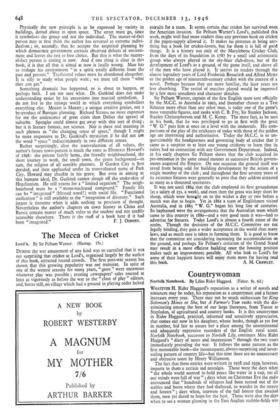The Mecca of Cricket
Lord's. By Sir Pelham Warner. (Harrap. 15s.)
DURING the war amusement of any kind was so curtailed that it was not surprising that cricket at Lord's, organised largely by the author of this book, attracted record crowds. The first post-war season has shown that this growing popularity was not transient. In spite of one of the wettest seasons for many years, " gates were enormous whenever play was possible ; evening newspapers' sales reacted at least as vigorously as before the war to the " close of play " edition, and, better still, no village which had a ground in playing order lacked recruits for a team. It seems certain that cricket has survived even the American invasion. Sir Pelham Warner's Lord's, published this week, might well find more readers than any previous book on cricket if the paper-supply allowed it. It makes no pretence at being any- thing but a book for cricket-lovers, but for them it is full of good things. It is a history not only of the Marylebone Cricket Club, from the days of its foundation in 1787 by a small and aristocratic group who always played in the sky-blue club-dress, but of the development of Lord's as a ground, of the game itself, and above all of the men who have played it. It carries its readers through the almost legendary years of Lord Frederick Beauclerk and Alfred Mynn to the golden age of nineteenth-century cricket with the interest of a novel. Perhaps because they are more familiar, the later years are less absorbing. The recital of matches played would be improved by a few more anecdotes and character sketches.
Sir Pelham Warner, captain of the first English team sent officially by the M.C.C. to Australia in 1902, and thereafter chosen as a Test Selector more often than any other man, is today one of the game's most venerable figures, and ranks with C. B. Fry, Sir Stanley Jackson, Stanley Christopherson and M. C. Kemp. The mere fact, as he says in his book, that he was privileged to go in first with the great " W. G." puts him at once on a level with the immortals. His com- parisons of the play of the cricketers of today with those of the golden age are interesting and authoritative. Today the M.C.C. is so un- questionably the headquarters and governing body of cricket that it came as a surprise to at least one young cricketer to learn that its rulers had no connection with any Government Department. Indeed, in his early chapters Sir Pelham shows that the club acquired its pre-eminence in the same casual manner as successive British govern- ments acquired the Empire. On one occasion the ground itself was saved from being sold for building development by the action of a single member of the club ; and throughout the first seventy years of its existence fixtures were generally so poor that they seldom attracted as many as a thousand spectators.
It was not until 1864 that the club employed its first groundsman (at a salary of 25s. a week), and even then the grass was kept short by sheep, which were brought on to the wicket a day or two before a match was due to begin. Yet in 1861 a team of Englishmen visited Australia, and in 1865 " W. G." began his long line of centuries. So haphazard were the arrangements that the Australian team which came to this country in 188o—and a very good team it was—had to advertise for fixtures. Today Lord's is almost a fourth estate of the realm. Though the decisions of the M.C.C. Committee are not legally binding, they gain a wider acceptance in the world than many laws, and as much care is taken in forming them. It is good to know that the committee are considering increasing the accommodation on the ground, and perhaps Sir Pelham's criticism of the Grand Stand may result in a more efficient building once the housing position makes such an improvement possible. All who look to Lord's for some of their happiest hours will enjoy them more for having read


































 Previous page
Previous page